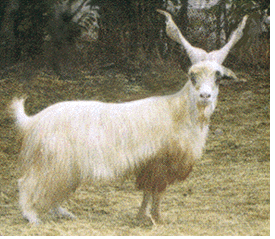...Best of Sicily presents... Best of Sicily Magazine. ... Dedicated to Sicilian art, culture, history, people, places and all things Sicilian. |
by Vincenzo Mormino | ||
Magazine Index Best of Sicily Arts & Culture Fashion Food & Wine History & Society About Us Travel Faqs Contact Map of Sicily |
--- Matthew 25:33 . . Could this Biblical reference explain why the innocent goat is considered stubborn, sinister (from the Latin for "left"), almost demonic, while sheep are viewed as docile and kind? Maybe it's those horns, but the allegory is simply a reflection of a far more ancient perception. Please don't think of me as an "old goat" for suggesting that in the Mediterranean region the negative folklore surrounding goats seems far older than Christianity, with ancient mythology peopled by fantastic creatures and naughty gods who are part goat, displaying the typical prurient inclinations attributed to this horned animal. Every region of Europe and Africa has its native ovine varieties, and the Agrigento goat (capra girgentana) today is one of Sicily's favourite but increasingly rare goat breeds. The domestic goat (capra hircus) is a hardy animal which, like the sheep, to which it is related, is useful for milk, meat and wool. In northern Europe and elsewhere, where summers are "shorter" and more humid, the sheep is more popular, folklore aside. Sheep are also widely raised in the Mediterranean region, but certain breeds of goat thrive on less water, often at higher altitudes, and are generally less selective about their diet. The Agrigento is primarily a dairy breed. Goats, which by definition appertain to the genus capra (sheep are in the genus ovis), are superior to cows for milk production in torrid and frigid zones. Domestic goats like the Agrigento breed probably descend from capra aegagrus, the Asian pasang. There are various caprine species, including the ibex. The name girgentana derives from the place name Girgenti, as modern Agrigento was known for centuries following the Arab rule of Sicily. This white goat with brownish head markings has prominent spiral horns that reach fifty centimetres in length. The adults average a standing height of around 70 centimetres, with males weighing as much as 70 kilograms. In contrast to most domestic caprine breeds, multiple births are normal among Agrigento goats, which produce exceptional quantities of milk. The breed's predecessors probably were introduced into Sicily from Africa or the Middle East. The Agrigento goat is strikingly similar to certain breeds in the eastern Mediterranean, including the Greek islands, but it is difficult to know when its ancestors arrived in Sicily --with the ancient Greeks, the Phoenicians, the Saracens, or perhaps in the era of trade that flourished during the Roman Empire. Except for some artistic representations depicting what appears to be this creature, very little documentary evidence reveals the Sicilian presence of the Agrigento goat, but at one time it was the dominant breed in southwestern Sicily, where only a few hundred specimens exist today. It has been present in Sicily for at least several centuries, and one hopes it will be for centuries to come. About the Author: Vincenzo Mormino has written about wildlife and nature for Best of Sicily and hard-copy publications. | |
Top of Page |
 "He will set the sheep on His right hand, but the goats on His left."
"He will set the sheep on His right hand, but the goats on His left."